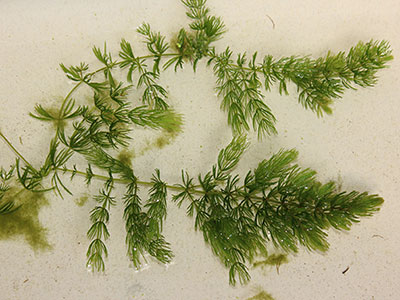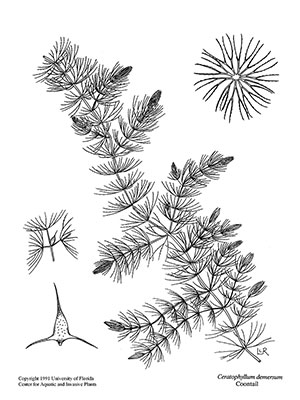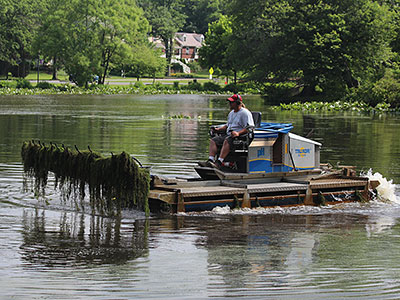Fact Sheet FS1236

Figure 1.
Description
Coontail sometimes called "Hornwort" is a common, dark green, submerged perennial aquatic plant (Fig. 1). While it lacks true roots, Coontail may be loosely anchored to the bottom by specialized, finely divided, buried or free-floating stems (rhizoids). The fanshaped leaves are relatively stiff and best observed in the water. They are arranged in whorls of five or more, with many forks and small teeth along the edge or midrib giving the plants a rough feel. The plants grow long and sparse and may reach lengths over 4.6 m (15 feet) but are often bushy near the tips giving the plant a "raccoon tail" or "Christmas tree" like appearance. They are often confused with water milfoil (Myriophyllum spp.) or fanwort (Cabomba caroliniana), but Coontail leaves are spiny and forked rather than featherlike. Coontail's flowers are very small and rarely seen. Reproduction is either by seed or by vegetative growth of plant fragments. Tiny flowers are located at the leaf base on very short stalks that never reach the surface. Pollination occurs underwater. Coontail pollen has adapted to being wet and can complete its entire lifecycle underwater producing a small, hard, oval seed with three spines (Fig. 2). It reproduces by seed formation and fragmentation. Fragmentation allows the plant to re-sprout and grow into new plants and they may overwinter or remain dormant in the sediment for long periods of time.
Distribution
Coontail is a native of the entire United States and most of Canada, and is found in many countries around the world. It can be found in freshwater to slightly brackish waterways and likes high nutrient levels. This plant species is sold as an aquarium or pond ornamental.

Figure 2.
Habitat
Coontail can be found floating on the surface and is capable of forming dense colonies covering large areas of water, but cannot tolerate periods of total emergence. It tends to grow as dense colonies in quiet waters of lakes, ponds, marshes and streams, at depths up to 6 meters (20 feet). It grows best in high-nutrient waters. Coontail can grow at relatively low light intensities and tolerates shade more than most submerged aquatic plants. The plants often stay green and continue to grow throughout the winter.
Impacts to the Aquatic Ecosystem
Coontail has tremendous value as a year-round habitat plant for young fish such as bluegill, perch and largemouth bass, as well as small aquatic insects. Some fish and waterfowl eat its shoots and seeds, although it is not considered an important food source.
Coontail is a competitive plant that can develop dense subsurface mats in high nutrient waters and displace or out-compete other native vegetation. It can reach nuisance levels, causing dense mats to deplete oxygen levels that can lead to fish kills, impede recreational activities, and create mosquito habitats.
Due to its ability to absorb nutrients from the water, coontail does provide a water quality benefit and may help to improve pond water clarity.
Prevention and Control
Coontail has no roots to obtain nutrients from the sediment. It absorbs nutrients directly from the water, so reducing nutrients from the water will ultimately suppress growth.
Lake water lowering is sometimes used to control aquatic vegetation. In this method, the lake water surface is lowered by several feet exposing the bottom sediments, along with nuisance Coontail plants. Plants are exposed to either freezing or desiccation, depending on time of year (NHDES 2010). "The timing, duration and extent of lowerings are tailored to each situation and are designed to avoid or minimize the loss of fish, and impacts to other biota" (NJDF&W 2011). It should be noted that while dewatering to expose the plants during the summer or exposure to a hard freeze during the winter will reduce growth from existing vegetation and fragments, the seeds can withstand severe conditions and may survive for re-infestation. In New Jersey, any drawdown of a waterbody may be subject to permitting from the New Jersey Division of Fish and Wildlife. Visit state.nj.us/dep/fgw/fishperms.htm#lowering for more information.

Figure 3.
Mechanical Control
Coontail can be harvested by cutting, raking, or mowing. Care must be taken because it can reproduce from small fragments left behind (Fig.3). Removing and destroying stem fragments from recreational equipment like motor propellers can help control Coontail stands. Mechanical harvest has shown to be effective by using methods such as suction dredging.
Several types of bottom barriers that cover and shade the bottom will smother infested areas. Barrier materials include polyvinyl chloride sheets, small mesh screens, and natural fibers. It is best to install barriers in the spring before plants produce a large biomass or exceed 50 cm (20 in) in height (DiTomaso and Kyser, et. al., 2013).
Biological Control
Triploid sterile Grass Carp (White Amur) are non-native herbivorous fish that will consume and control Coontail, but only after eating any preferred aquatic plants that may be present. These fish are strictly controlled in New Jersey (and other states) and may be purchased only from an approved hatchery after applying for, and receiving, the appropriate state permit. Contact the New Jersey Division of Fish and Wildlife Bureau of Freshwater Fisheries for more information by visiting state.nj.us/dep/fgw/fishperms.htm#stocking.
Chemical Control
Contact herbicides such as diquat, endothall, and various chelated copper products have been shown success in treating Coontail, but results are often short-lived and expensive. Contact herbicides are quick-acting and kill the cells of the plants they come in contact with. Plant surfaces that aren't contacted by the herbicide will not die and additional treatments will be required. Coontail is also susceptible to systemic herbicides containing 2,4-D and fluridone, which are absorbed directly into, and move internally throughout, the plant. They can be very effective, however they take a longer time to act (become absorbed), so can only be applied in water bodies with minimal to no water exchange (Langeland et.al. 2009). A more detailed review of aquatic pesticide use can be found in Rutgers Cooperative Extension Fact Sheet FS386, "Aquatic Weed Control" (Hart, 2001).
- New Jersey Department of Environmental Protection administers the regulations regarding application of chemicals to waterways in New Jersey. Aquatic pesticide applications require a permit and certified applicator.
- The algae must be properly identified. Most herbicides control only certain plant types as indicated on the product label.
- Consider the use of the waterway to be treated. Most herbicides restrict the use of the water until the herbicide has been degraded, inactivated, or dissipated.
- Calculation of water area/volume to be treated is needed for proper dosage.
- Method of application may affect pesticide choice if a certain type of equipment is needed for treatment to be effective.
- Timing is important when deciding which herbicide to use. It is best to treat early in the season when plants are just beginning to grow and not firmly established. This will reduce the amount of algae to be killed and lessen the chance of fish kills due to low dissolved oxygen caused by decaying plants.
- Water temperature affects the efficacy of some herbicides. Application should be when Coontail is actively growing with a compatible temperature. Label recommendations should always be followed.
References and Resources
Figure 1. Coontail photograph courtesy of Mike Haberland.
Figure 2. Coontail illustration showing growth form. Courtesy of University of Florida Center for Aquatic and Invasive Plants.
Figure 3. Mechanical removal of Coontail photograph courtesy of Mike Haberland.
July 2014
Copyright © 2024 Rutgers, The State University of New Jersey. All rights reserved.
For more information: njaes.rutgers.edu.
Cooperating Agencies: Rutgers, The State University of New Jersey, U.S. Department of Agriculture, and Boards of County Commissioners. Rutgers Cooperative Extension, a unit of the Rutgers New Jersey Agricultural Experiment Station, is an equal opportunity program provider and employer.

